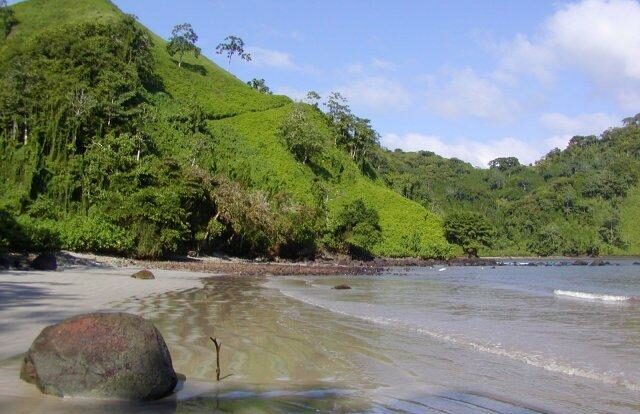Coco’s Island: the best kept secret of Costa Rica

When Robert Louis Stvenson wrote “Treasure Island”, legend has it that he was probably referring to one of the world’s most important natural jewels located in Costa Rica: Cocos Island.
And although none of the 300 expeditions in search of the famous treasure have been successful, the truth is that the island, located 532 km off the Pacific coast of the country, is in itself one of the most outstanding natural treasures on the planet. It was declared a World Heritage Site by UNESCO in 1997 and is among the finalists to be designated as one of the 7 new wonders of the world. Declared a National Park since 1978, this magnificent island is recognized worldwide as one of the most exceptional reservoirs of biodiversity in the world. It is not for nothing that Commander Jacques Cousteau himself called it the “most beautiful island in the world” and explored it many times on his famous ship, the Calypso.
Location and administrative situation
Cocos Island is located in the Costa Rican Pacific Ocean, at the geographical coordinates 5°32′ North latitude and 87°04′ West longitude, at a distance of 500 kilometers from the Costa Rican coast. The total area of the PNIC is 203,483 hectares (2,034 km2). The terrestrial sector measures 2,330 hectares (23.30 km2) and the marine sector corresponds to the 12 nautical miles (201,153 ha or 2,011 km2).
The Cocos Island district was created in 1970 and currently constitutes the 10th district of the Puntarenas canton (IGN, 2009). The island has no native inhabitants, but it does have ACMC staff, researchers, volunteers and tourists. This protected area is under the administration of the Cocos Marine Conservation Area (ACMC), of the National System of Conservation Areas (SINAC), an organ of the Ministry of Environment and Energy (MINAE).
History of Cocos Island
According to the NGO FAICO, the history of Cocos Island comprises 7 different stages:
I. Discovery Period
It is said that the island was discovered after 1531 and before 1542 by the navigator Johan Cabezas.
II. Period of Pirates, Corsairs and Treasures
During the XVII and XVIII centuries it was a refuge for pirates and corsairs due to the abundance of fresh water, wood, fishing and coconuts. According to legends, valuable treasures were hidden on the island, among which the captains’ treasures stand out:
Edward Davis who arrived on his ship Bachelor’s Delight in 1685-Bennett
Graham on his ship Devonshire in 1818-Benito
Bonito with his ship Lighning in 1820
Mary Dear in 1821, known as the Treasure of Lima.
III. Whaler Period
The island served as a supply station for fresh water, wood and firewood, as well as a resting place for the numerous whaling crews that operated especially around the Galapagos Islands. Although this historical period is richly documented in the logs of the whalers, it has been scarcely studied.
IV. Period of Explorers and Scientists
1791: Alejandro Malespina with his ships Descubierta and Atrevida sent by the Spanish Crown to carry out a hydrographic survey of the American Pacific.
1795: Georges Vancouver of the British Admiralty1838
: Edward Belcher on the ships Sulphur and Starling1888
: the United States Fish Commission on the Albatross1899
: Hopking Stanford on the schooner Julia Whalen1905
: the California Academy of Sciences1924
: the British Museum sponsored on the sailing ship Saint Georges1921-1928
: William Vanderbilt’s on the yachts Eagle and Ara1930
: Vincent Astor on the yacht Nourmhal1932
: Allan Hancock on the motor cruiser Velero III
No definite date: the scientist Alexander Agassiz
Among others…
V. Penal and Agricultural Colony Period
Penal Colony (1879-1881) – agricultural colony (1884-1912)
The first colony installed had an ephemeral life but established agricultural activities with the respective logging of the forest.
The second was promoted by August Gissler, who was appointed Governor of Cocos Island and had a variable development over time, with the presence of German settlers. During this time an intensive search for the treasure was carried out.
VI. Treasure Seekers Period
It begins in the first quarter of the 19th century and ends in 1992 with the last treasure hunting expedition of John Hodges and Leonel Pacheco in the ship Dulcinea.
To date, it is estimated that more than 300 treasure hunting expeditions have been undertaken, to no avail.
VII. Protected Area open to tourism
In 1978 the Government of Costa Rica created the Cocos Island National Park which was later declared the core of the Cocos Marine Conservation Area.
STAGGERING FIGURES
Although none of the treasure hunters who have ventured to Cocos Island have actually found anything, the true richness of the island lies in its flora and fauna. Despite its small size, the island has been identified:
– 235 plant species (10 endemic terrestrial vascular species and 48 non-vascular species, one endemic orchid and 17 endemic ferns)
– 90 species of mushrooms.
– 362 species of insects (of which 64 are endemic),
– 5 species of reptiles (2 endemic terrestrial species),
– 97 bird species (12 resident, 3 endangered and 3 endemic),
– 60 species of arthropods (57 species of crustaceans and 3 species of spiders).
As for marine species, its waters are home to more than:
– 30 unique marine endemic species that represent more than 40% of the total number of marine endemic species in the world.
– 57 species of crustaceans,
– 510 of marine molluscs,
– more than 250 fish (of which 5 are freshwater and 3 are endemic),
– 3 species of sea turtles and
– 32 of corals.
Among the most emblematic marine species are giant manta rays, humpback whales, leatherback and olive ridley turtles, bottlenose dolphins, whale sharks, white tip sharks and hammerhead sharks (the island is home to the largest congregations of hammerhead sharks).
IN SUMMARY
- Cocos Island is in itself one of the most outstanding natural treasures on the planet. It was declared World Heritage of Humanity by UNESCO in 1997.
- It was declared a National Park in 1978, and is recognized worldwide as one of the most exceptional reservoirs of biodiversity in the world.
- To date, it is estimated that more than 300 treasure hunting expeditions have been undertaken, with no known results.
SITES OF INTEREST
https://isladelcoco.go.cr/
Author:
Sensorial Sunsets
www.sensorialsunsets.com
Navigate articles





